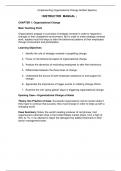(Implementing Organizational Change 3e Bert Spector)
( INSTRUCTOR MANUAL )
CHAPTER 1: Organizational Change
Main Teaching Point
Organizations engage in a process of strategic renewal in order to respond to
changes in their competitive environment. But in order to make strategic renewal
work, leaders must find ways to alter the behavioral patterns of their employees
through involvement and participation.
Learning Objectives
1. Identify the role of strategic renewal in propelling change.
2. Focus on the behavioral aspect of organizational change.
3. Analyze the dynamics of motivating employees to alter their behaviors.
4. Differentiate between the three faces of change.
5. Understand the source of both employee resistance to and support for
change.
6. Appreciate the importance of trigger events in initiating change efforts.
7. Examine the role ―going global‖ plays in triggering organizational change.
Opening Case—Organizational Change at Nokia
Theory into Practice of Case: Successful organizations cannot remain static if
they hope to continue that success; they must change in order to keep up with a
changing world.
Case Summary: Nokia, the world’s leading producer of cell phones, had
experienced a dramatic drop in the United States market share, from a high of
35% to 7%. In an attempt to repair the damage they added Americans to their
senior management team.
Copyright © 2013 Pearson Education, Inc. publishing as Prentice Hall
,Analyzing the Case
1. What was the primary cause of Nokia’s drop of market share in the United
States?
Perhaps the most damaging cause was Nokia’s lack of responsiveness to
the shifting tastes and expectations of US customers—especially
smartphones.
2. What technological decision did Nokia make which led to their difficulties in
the United States?
Nokia built its phones on the European standard GSM format rather than
the US standard CDMA format. That decision limited access to the US
market, where over half the phones operated with CDMA.
3. What market decision did Nokia make which impacted their effectiveness in
the United States?
Nokia failed to forge close ties with wireless providers, instead offering
open phones that would then need to be adapted to a particular provider.
Nokia’s approach worked well globally. In the US, however, wireless
providers—Verizon, Sprint Nextel and AT&T, which together controlled 96
percent of the US market—wanted to offer phones themselves that could
be co-branded and bundled with long-term service contracts.
4. In 2010, the Nokia board recruited Stephen Elop from Microsoft to transform
the global giant. What internal operational barriers did he discover?
Elop publically admitted that Nokia had grown complacent and removed
from customers. Instead, ―It was management by committee,‖ said one
executive describing the company’s approach to innovation. ―Ideas fell
victim to fighting among managers with competing agendas, or were
rejected as too costly, risky, or insignificant for a global market leader.‖
5. What was one of the first moves that Elop made to stem the loss of US
market share? Why did he make this move?
One of his first moves as new CEO, Elop announced job cuts. The cuts
were intended, he said, to streamline software development for Nokia’s
smartphones by improving ―agility and responsiveness‖ in the software
development and Web services units.
Copyright © 2013 Pearson Education, Inc. publishing as Prentice Hall
,Lecture Outline
1. Strategic Responsiveness
A. Overview:
Stephen Elop was just one of many business leaders facing the challenge
of organizational change. Recognizing the need to change is important, of
course, but it’s just a first step.
B. Next comes change implementation—the actions taken by
organizational leaders in order to support strategic renewal and achieve
outstanding performance. Successful implementation is required to
translate that recognition into an effective strategic response. Poor
implementation can undermine the best intentions of organizational
leaders.
C. Many factors require organizations to change, such as significant
alterations in customer expectations and demands, new technologies,
competitors with innovative business models, shifts in workforce
demographics and values and new societal demands and constraints.
D. In response to those dynamics, organizational leaders often decide to
engage in a process of strategic renewal. Strategic renewal involves
some combination of a new product or service, a new market, and a new
business model for an organization.
E. There is ongoing demand for strategic renewal created by an ever-shifting
competitive environment. See Exhibit 1-1 for examples.
F. For strategic renewal to be effective, organizations need to do more than
announce a new strategy.
G. Leaders need to align internal processes, structures and systems with the
demands of that new strategy. New organizational capabilities—talents
and skills possessed by employees—need to be built. Underlying all those
shifts is the requirement to engage in discontinuous change: large-scale,
long-term reorientation of most or all of the central aspects of
organizational life. The goal is to create lasting alterations in patterns of
employee behavior in order to support strategic renewal.
Copyright © 2013 Pearson Education, Inc. publishing as Prentice Hall
, 2. The Three Faces of Change
A. Although there are many diverse approaches, they can be placed within
one of three broad categories: turnaround, tools and techniques, and
transformation.
B. Turnaround is an attempt to improve the immediate financial position of an
organization by focusing on the income statement and the balance sheet.
C. Tools and techniques are organizational processes, mechanics, and other
interactions intended to produce a product or service. See Exhibit 1-2 for
popular change tools and techniques.
D. Transformation, which focuses on behaviors, involves a change
intervention that directly targets patterns of employee actions and
interactions.
E. Three Faces of Change, in summary:
Type Target Rationale
Turnaround Assets Improve short-term bottom-line
performance
Tools and Processes Increase internal efficiencies
techniques
Transformation Behaviors Enhance human capabilities
Copyright © 2013 Pearson Education, Inc. publishing as Prentice Hall




